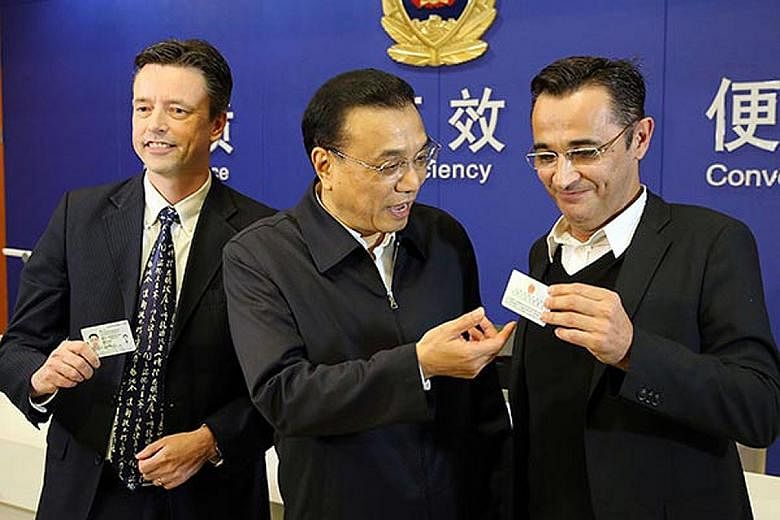To attract more global talent and investments, China plans to introduce a new green card that will be more widely recognised to make life easier for permanent residents (PR), whose numbers are still very small in the country.
But some PRs told The Straits Times that the new card, to be introduced by the end of this year, is not vastly more attractive and may not help the world's second largest economy turn into a magnet for foreign professionals and funds.
A meeting of the Central Leading Group for Comprehensively Deepening Reforms chaired by Chinese President Xi Jinping earlier this month called for further reforms in China's immigration policy.
"The reforms should serve the country's talent development strategy, address public concerns, optimise the design of the card and improve the information system," according to a statement released by Xinhua news agency.
Efforts should also be made to ensure that green-card holders enjoy all rights related to residency, the statement added.
"This simply means the card will be made more useful," said Dr Wang Huiyao, president of the Centre for China and Globalisation, a Beijing-based think-tank.
-
CHINA'S GREEN CARD
-
• From 2004 to 2013, a total of 7,356 foreigners obtained the card.
• Last year, 1,576 foreigners became permanent residents in China, up 163 per cent from 2015.
The number of green card applications in Beijing also rose 426 per cent compared with 2015 and Shanghai saw a six-fold increase year on year.
• More than half of the green-card holders live in Beijing, Shanghai and Guangzhou.
• The top five countries of origin of green-card holders are the United States, Japan, Canada, Australia and Germany.
• Around half the card holders obtained the cards to live in China with their Chinese family members. A third are professionals working in China and who made contributions to the country's development. About 15 per cent of them are senior executives in multinational firms or technology companies or are professors in universities. A small number are foreign investors and their family members.
"Currently, the card is not included in China's identification-card system. So it is not possible for green-card holders to use their cards like how Chinese citizens use their identification cards," he told The Straits Times.
In theory, foreigners holding the green card have the same rights as Chinese citizens, except for political ones. The card - renewable every five or 10 years - allows PRs to live in China without a visa, buy property and enrol their children in public schools.
Card holders are also covered by social insurance, and those who are unemployed can receive pensions and health insurance.
But, in reality, PRs in China say the document is not well recognised in the country, and they could not use it in most situations. And most PRs do not try to claim the social benefits as their expatriate packages usually cover housing, education and insurance for themselves and their dependants.
Introduced in 2004, the Chinese green card is thought to be one of the hardest to get worldwide, because of its complicated application process and high threshold for qualification.
By 2013, only 7,356 foreigners had become Chinese PRs, out of the more than 600,000 foreigners living in China.
Singaporean Tan Chong Ming, 47, a senior executive with a multinational telecommunications company who lived in China from 2003 to last year, obtained his green card in 2011. He told The Straits Times he had spent nearly a year gathering the paperwork, made multiple visits to the immigration office and waited for more than a year before getting the card.
Measures to improve the green card come as foreign direct investment in China last year fell for the first time in four years - it dropped by 7 per cent to US$126 billion (S$177 billion) as a result of increased business costs in China.
Last year, the Chinese government rolled out a slew of measures in Beijing, Shanghai and Guangzhou in order to speed up the process and lower the criteria for qualification.
This resulted in a 426 per cent jump in the number of green-card applications in Beijing last year from a year earlier, said the Ministry of Public Security.
But even if green-card holders can enjoy more practical use of the card, this is not seen as a huge draw to foreigners.
Mr Tan Wee Theng, 63, a Singaporean businessman who became a Chinese PR in 2004, said the biggest advantage of the card is that it allows him to live in China without a visa and he is able to pass through immigration via the automated gantry each time he enters or leaves the country.
As for Mr Tan Chong Ming, he said the card gave him the option of retiring in China.
"For other foreigners, they would need to be employed in order to live in China, but not for me," said the father of two teenage children who is married to a Chinese citizen.
Another Singaporean business owner, Ms Jessie Lim, 38, said some of her foreign friends who have been in China for more than 10 years have rejected green-card offers as they also see no need for one. But if the new card makes it easier for foreign residents to invest in property, it could entice more people, including herself, to consider applying.

